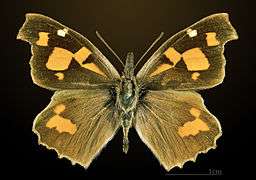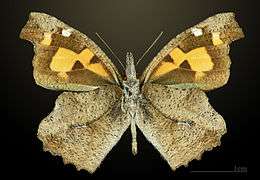Libythea celtis
| European beak | |
|---|---|
 | |
| France | |
_Bulgaria.jpg) | |
| on mint, Bulgaria | |
| Scientific classification | |
| Kingdom: | Animalia |
| Clade: | Euarthropoda |
| Class: | Insecta |
| Order: | Lepidoptera |
| Family: | Nymphalidae |
| Genus: | Libythea |
| Species: | L. celtis |
| Binomial name | |
| Libythea celtis (Laicharting, 1782) | |
Libythea celtis, the European beak or nettle-tree butterfly, is a butterfly of the Libytheinae group of the brush-footed butterflies family.
Description
The upperside ground colour is rich silky brown. The forewing has the cell filled with a broad orange-yellow streak which is subapically deeply indented above; a small discal orange-yellow spot present in interspace 1; a much larger, similarly coloured discal spot between veins 2 and 4, on the inner side touching the cell between veins 3 and 4; a subcostal white preapical spot and a quadrate double spot in interspaces 4 and 5, placed obliquely forward to the subcostal spot; this spot whitish above, orange below. Hindwing uniform, with an irregular curved, transverse, upper postdiscal orange patch extending from just below vein 3 to interspace 6, the portion in interspace 6 often detached. Underside ground colour: forewing brown, apex pale purplish irrorated (sprinkled) with minute dark transverse striae and dots, orange markings as on the upperside but paler; hindwing uniform pale purplish irrorated with minute dark dots and transverse striae. Antennae, head, thorax and abdomen dark brown; beneath, palpi, thorax and abdomen concolorous with the tint of the underside of the hindwing.[1]
 Dorsal side
Dorsal side Ventral side
Ventral side
Its range is southern Europe, Asia Minor and the Chitral ranges of Pakistan.
References
- ↑ Bingham, C.T. (1905). The Fauna of British India, Including Ceylon and Burma Butterflies. 1 (1st ed.). London: Taylor and Francis, Ltd.
External links